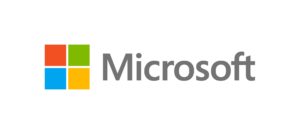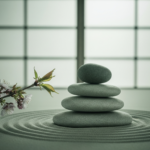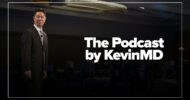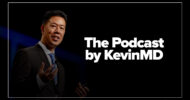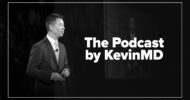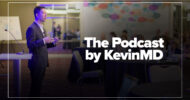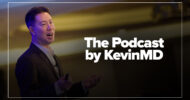Subscribe to The Podcast by KevinMD. Watch on YouTube. Catch up on old episodes!
Physical therapists Kim Downey, Ziya Altug, and Shirish Sachdeva discuss their article “How physicians can reclaim resilience through better sleep, nutrition, and exercise.” In this episode, Kim, Ziya, and Shirish explain how the triad of sleep, balanced nutrition, and physical activity forms the foundation of physician resilience. They outline practical strategies such as circadian-friendly sleep routines, meal planning to stabilize energy and mood, and integrating aerobic activity with mindful practices like yoga. The conversation emphasizes small, sustainable changes, institutional supports, and peer accountability systems that make self-care realistic for busy clinicians. Listeners will come away with actionable lifestyle medicine strategies to reduce burnout, strengthen work-life balance, and improve both personal health and patient outcomes.
Our presenting sponsor is Microsoft Dragon Copilot.
Microsoft Dragon Copilot, your AI assistant for clinical workflow, is transforming how clinicians work. Now you can streamline and customize documentation, surface information right at the point of care, and automate tasks with just a click.
Part of Microsoft Cloud for Healthcare, Dragon Copilot offers an extensible AI workspace and a single, integrated platform to help unlock new levels of efficiency. Plus, it’s backed by a proven track record and decades of clinical expertise, and it’s built on a foundation of trust.
It’s time to ease your administrative burdens and stay focused on what matters most with Dragon Copilot, your AI assistant for clinical workflow.
VISIT SPONSOR → https://aka.ms/kevinmd
SUBSCRIBE TO THE PODCAST → https://www.kevinmd.com/podcast
RECOMMENDED BY KEVINMD → https://www.kevinmd.com/recommended
Transcript
Kevin Pho: Hi, and welcome to the show. Subscribe at KevinMD.com/podcast. Today we welcome Kim Downey, Ziya Altug, and Shirish Sachdeva. They’re all physical therapists and physician advocates. Today’s KevinMD article is “How physicians can reclaim resilience through better sleep, nutrition, and exercise.” Everybody, welcome to the show.
Kim Downey: Thanks, Kevin.
Ziya Altug: Thank you, Kevin.
Shirish Sachdeva: Thank you for having us.
Kevin Pho: All right. Kim has been on many, many times and always brings together an eclectic group of physician advocates. So Kim, how did you bring everyone together today?
Kim Downey: Yes, Ziya connected with me on LinkedIn a while back, and then Shirish reached out to me after I commented on one of Dr. Jonathan Fisher’s posts. We started communicating and then we got to meet in person at Jonathan’s book launch party a little over a year ago, and that was fantastic. So then they were connected, and we just started communicating and supporting each other’s posts. My thought for this article was that I wanted to spotlight more health care professionals that doctors can have in their back pocket professionally and personally.
I’ve had a registered dietitian on my YouTube channel, and she’s been on with you to highlight how they can help doctors by helping their patients and also how they can help the doctors themselves. I also had on a local pulmonologist for the same reasons, and doctors know that good sleep, nutrition, and exercise are important for the health of their patients, though they frequently don’t prioritize these things for themselves.
I was trying to look up statistics and I found that just 25 to 30 percent of doctors exercise, but they would tell all of their patients that exercise is important. So I wanted to collaborate with a couple of physical therapists here to emphasize the importance of these self-care approaches for the doctors themselves.
Kevin Pho: Wonderful. All right. Let’s talk about the article itself. Shirish, just tell us about the article and what inspired you to collaborate with Ziya?
Shirish Sachdeva: Yes. Ziya did reach out to me, I think in June of this year. Kim and Ziya had already collaborated on this idea and the thought, and they offered this concept to me. I was happy and gracious. I thought, “This is an awesome topic,” because on a day-to-day basis, we deal with this issue of not getting our lifestyles in order. We’re bombarded with so many things on a day-to-day basis with our work and with the multiple different responsibilities that we have.
So I thought, “This is a no-brainer. We have to help our helpers on a day-to-day basis.” So I said yes and I was looking for some stats, as Kim was mentioning. We’d seen that there was a study in Taiwan that was done on a hospital group, and every different profession was examined. This was done in 2018 by Dr. Yi and his colleagues. What they came out with was that the most strained group in the whole hospital community, when they were examining for metabolic syndrome, were the physicians.
The total population that was examined was around 6,700 people, and about 18.3 percent of them had metabolic syndrome. Among physicians, the overall percentage was 12 percent. So physicians took the lead on having these issues. I think we can’t have a healthy community if we don’t have people who provide health to others form the same sort of consensus among their own selves. So that was the reason primarily why I joined in this venture.
Kevin Pho: Thanks, Shirish. Just for those who don’t know what metabolic syndrome is, give us a quick 30-second primer on what that is.
Shirish Sachdeva: So we’re looking at a cluster of different syndromes in it. You can talk about central obesity. You can look at high blood pressure. You’re having high cholesterol, primarily triglycerides, and a low HDL, which is high-density lipoprotein. So you have those built in together.
It sometimes tends to lead to other issues like diabetes. We call it syndrome X, which is also built in with metabolic syndrome. These multiple syndromes can develop in one single person, with gradual year-to-year, decade-to-decade insult to the body over time, adding up multiple issues. That’s primarily where this stems from.
Kevin Pho: So Ziya, that study that was just cited where physicians are taking the lead in metabolic syndrome, that’s not something that anyone really wants to lead on. What are some of the reasons that you think are behind that?
Ziya Altug: Well, the study that I am familiar with that I’ve prepared for is the 2025 study that was in the American Surgeon. And they were talking about self-care, about how diet and nutrition and exercise and other self-care aspects were beneficial for physicians. But I think if it’s beneficial for physicians, it can also be beneficial for nurses, other therapists, and the whole health care community.
Kevin Pho: And Ziya, specific to the health care professionals that we’re talking about, what are some simple ways that we can improve those numbers? As you know, those of us in health care work very long shifts, are very busy, and have very little time to take care of ourselves. What are some simple strategies that you implement whenever you talk to health care professionals?
Ziya Altug: I think the simple strategies include creating a toolbox for each person. So my toolbox may be different than Kim’s toolbox, and Kim’s toolbox may be different than yours. This means putting in that toolbox things that resonate with that person. One person may feel comfortable doing a five- to ten-minute Tai Chi program. Another person may feel comfortable doing a mini yoga program. Another person might go out and walk. Other people might have hobbies to de-stress after their shift, which might include pottery, music, playing the piano, and engaging in other hobbies.
Kevin Pho: And Ziya, when you talk to these health care professionals, how do you discern what comes naturally to them? What resonates with them? Is it just through simple conversation? Do you have a specific set of questions that you ask these health care professionals? How can you individualize your suggestions to them?
Ziya Altug: If I’m working with somebody in a physical therapy setting, I have more time because I’ve done a good evaluation and have done outcome measures and so forth. However, if I’m just speaking with a group, I have everybody think for themselves in terms of what the best things are and what feels good for them: just going out for a walk, maybe exercising, playing the piano, working in their garage on their car. People intuitively know the things that make them feel better, and it’s leaning on those things that give the person that comfort.
And for individuals that don’t know, who have never tried things like body scan meditation or five-finger meditation or other types of meditation, maybe they need to go out and do some exploration. Maybe take a yoga class, see if it resonates with them, take a Tai Chi class, see if it resonates, or go into the woods and do a hike. I think exploration is the key.
Kevin Pho: Kim, you’ve done such a wonderful job advocating for physicians, not only highlighting some of the obstacles that we face every day, but also providing solutions. These aren’t just solutions from other physicians; you’ve brought together health care professionals from the allied health professions. You brought dietitians, physical therapists, like we’re doing now. Why is it important to include a whole spectrum, a holistic approach, so to speak, to address the issue of physician burnout?
Kim Downey: Well, I think when doctors share things on LinkedIn, sometimes it can feel like a vacuum and they’re preaching to the choir or just talking to each other. So when I bring other people on, it helps doctors know that there are other people on your side and in your corner, and they can help you. Sometimes it is physicians, like the pulmonologist, who will tell doctors when they should seek sleep help themselves.
But then to know that there are dietitians out there and they can help your patients because you don’t have time to talk about nutrition. So send them to a dietitian and everybody wins. And then it’s the same thing with physical therapists. Because I’ve seen stories where surgeons ended up not being able to practice anymore. They were in so much pain that there was a dead stop that affected them permanently because they kept pushing through. I want to spotlight that you can reach out to a physical therapist too. We tend to be smart and kind and good team players, and we’re used to collaborating (PT, OT, speech) and to just spotlight for doctors that there are other people out there to help you, help your patients, and to help you.
Kevin Pho: So Shirish and Ziya, I’m going to ask you similar questions. Have you, in a physical therapy session, worked with a physician? What kind of issues did they come to you with in a physical therapy session, and how did you address it?
Shirish Sachdeva: I was just thinking about that as Kim was talking about the story with the surgeon. I had a gastroenterology surgeon early on in my career who had ankylosing spondylitis, and he used to have extreme pain. He was well aware of it and he would stand throughout the day in surgeries with the heavy lead coat on him, and that would literally break his back, to the point where he could not practice. So early morning before his shift, he would come in the hospital setting to our PT department. He was the first patient, opening the door with us, and he would stay for an hour.
We would do a full comprehensive rehab for him, and then he would go straight into the OR after that, spend his couple of hours, come back during his lunchtime, spend another 15 to 20 minutes with us, and then go back again after his lunch into the OR. This showed one thing. I was early in my career at that time and was unaware of lifestyle medicine. I was pretty much not aware of those things. So I saw a holistic thought process. I thought, “OK, a physician, a surgeon at that point, taking care of himself before he takes care of others was a good example that was being set when I was training.” This was me training in a tertiary care hospital. That was something that I saw.
And again, since then, it’s been time and again, we have seen physicians come to us. There’s no day that goes by that I don’t have either nurses or physicians in my clinic who come in with multiple different issues. Again, we have top charts of back pain, spinal pain, muscle pain, joint pains; all those are there, no doubt. But frankly, 80 percent of the people that come in our clinic, physicians included and other clinicians included, 80 percent of them have a diabetes diagnosis. That is set up on their chart. And this is what we see from APTA’s recent stats.
This is too much. And I’ll say that in my clinic, I personally see about 100 to 115 patients a week. That multiplied by 52 weeks, and you can pick 80 percent of those having such metabolic disorders. That’s way too much. We have to do something about it. So we definitely have to collaborate on this, and there’s no better way to have all team members on it.
Kevin Pho: And Shirish, what are some simple ways that clinicians can move better? What are some simple physical things that they could do? I know Ziya mentioned some individualized things like Tai Chi and whatnot, but from your perspective, what are some easy things that physicians can implement?
Shirish Sachdeva: We’ve also highlighted this in our article. And we’ve brought in some of these tidbits, small little churnable points that we bring in with an example. I’ll go on those and where we’re trying to save time during the day, our 24 hours are limited. So in those 24 limited hours, eight hours are gone to sleep. This is if you are sleeping eight hours. That is another point we make. But to add to that, in 16 hours awake, there are multiple small little things anyone and everyone can do every hour.
And this is a daily task that I talk to people about. I say, “Move your neck every hour. Turn it left, right, up, down. Use it to stretch.” It takes three minutes at the top to get those movements in. It’s just about memorization and repetition of those things. Stand up from your desk. If you are in a sitting job, if you are doing charting, try and have standing desks. Stand up, sit down, modify yourself. Be creative. Walks in between patients can be helpful. Moving from one spot to another can be useful. Having a walk with the patient at times helps out.
Sometimes in our clinic, we’d have people who have gait therapy and we will have them walk outside the clinic, around the whole building. And that adds up well to my steps. This is the self-care I’m adding in there. So, they don’t know that we’re getting them into a functional environment. I think physicians can do the same. We can use our socially available timeframe as well as the environment to bring in those small micro-breaks. I know Dr. Jonathan Fisher, as Kim spoke about, I follow him and his ideology. Small little things he does in his daily routine, like taking that five-minute break in another room and just doing a little small meditation for himself. Calming down his breath. This type of work really helps.
Controlling our autonomic system in the super-stressful environment that we live in. And again, I think, I can hardly stress anymore that physicians on top of this chain have the most stress in hospitals, in emergency departments where you can forget taking a breath at times because you’re jumping from one patient to another.
Kevin Pho: Ziya, tell us about an encounter that you had with a clinician and the problem that they came to you with, the solution that you proposed, and you really moved that needle in that individual clinician. Tell us a story.
Ziya Altug: Yes, thank you. I do have a patient that I recall years ago that came to the clinic when I was working at a large hospital, and he was a neurosurgeon. He came in with back pain, and again, as Shirish had mentioned, the prolonged standing using tools in front of their body for prolonged periods of time with no rest periods because the patient is under anesthesia. But he had told me just through conversations in the physical therapy that we were doing, he had told me two things that worked for him and perhaps this will resonate with other individuals. For his hands and for his anxiety and stress, he used pottery because the pottery, where he put his hands on it, was like a massage to the hands, and he was creating something. He was in a social group, and for him, he found the pottery was very good. In fact, he even bought a kit for his own home, but he still enjoyed going to the facility to do that with other people.
And in terms of movement, he had tried many different types of things: strength training, flexibility exercises, and he was a runner. But none of those really seemed to impact his back pain. The one thing that he did find was dancing with his wife because dance, as he was saying, is different movements. You don’t move the same way. And he said the repetitive movements just weren’t working enough for him to loosen up his back. But the various dances that he and his wife were doing were excellent. He was going to a studio to do this, and that made him feel the best.
Kevin Pho: We are talking to Shirish Sachdeva, Ziya Altug, and Kim Downey. They’re all physical therapists and physician advocates. Today’s KevinMD article is “How physicians can reclaim resilience through better sleep, nutrition, and exercise.” Now, I’m going to ask each of you just to share some take-home messages with the KevinMD audience. Ziya, why don’t you go first?
Ziya Altug: My take-home message is that I think self-care techniques should be taught even as early as high school and perhaps even elementary school and junior high school, different aspects of it so that when people are getting into their professional life, it becomes second nature.
Kevin Pho: Shirish, what are your take-home messages?
Shirish Sachdeva: I will piggyback on that, but I’d say start small and self-care is the most important care that you can begin with. So pick one thing that you can change and go with that change for a period of time, which is easily manageable, and you can monitor that change. Take it from A to Z, and then move to the next change. I give this example to many of our patients. So many years pass by, but if for six months you work on one change, you could have had six changes in the last three years. So I think that starts today. If you can, pick one. Start small, do something. It could be a ten-minute walk. It could be focusing on eight hours of sleep, or it could be food that is not eaten from a vending machine and is home-cooked. So anything on those lines, whatever you feel, or as Ziya said, taking a yoga class or Tai Chi or anything on those lines. But make sure you start putting focus on yourself before we engage with others.
Kevin Pho: And Kim, as always, we’ll end with you. What are your take-home messages for the KevinMD audience?
Kim Downey: Sure. So a few words that are mentioned in this article include resilience, burnout, and yoga. And some doctors cringe when they hear any of those words because resilience, they say, understandably, “We’re some of the most resilient people on the planet.” Which is true, but it’s like throwing the baby out with the bathwater because resilience actually means going through something challenging and coming out stronger. So the principles that we highlight in this article are ways that you can shore yourself up.
And the same thing with burnout. Some doctors think that burnout makes it feel like an individual problem where it really is the system that’s the problem. And if you would fix the systemic issues, they wouldn’t be burned out. I get that, and that’s true. They prefer the term moral injury. They have different definitions and you can have burnout or moral injury. But again, speaking to that, while we are trying to change the system, and I think more and more people are raising their voices, there are still these points that we have that can help you individually.
And even yoga, a lot of doctors, that’s the big thing. They’ll say, “We don’t need pizza parties and yoga.” And yoga might not be for you, but literally a doctor, the first time I talked to her, in our first conversation, she said, “Yoga saved her life.” And I know men and women physicians who really do love yoga and it might not be for you, but it’s just to open your mind to try some of these things.
And also, you shouldn’t need permission. And you don’t need permission. But if you feel like you do, we’re giving you permission to put yourself first. Because some doctors will think like Dr. Michael Hirsch. He was told he couldn’t have a lunch break. It would throw off the schedule as a gastroenterologist. But when he decided, “I need my lunch,” and by him speaking up for himself, then other doctors reached out. But it was almost like they needed permission to ask for basic things, and these things should be prioritized: sleep, nutrition, exercise. So exercise your own sense of personal agency, and we need doctors to be healthy for us and for themselves.
Kevin Pho: All right, everyone, thank you so much for sharing your perspective and insight. Thanks again for coming on the show.
Kim Downey: Thank you, Kevin.
Ziya Altug: Thanks for having us, Kevin.
Shirish Sachdeva: Thank you for having us.


